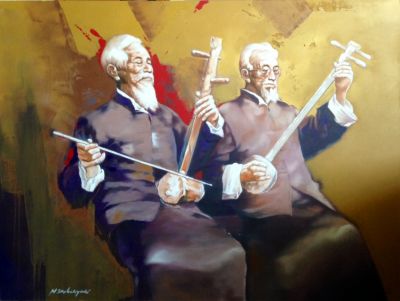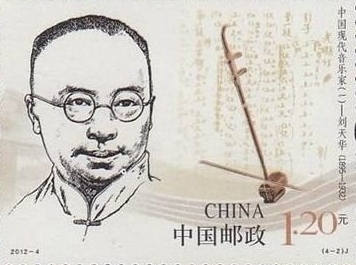Erhu
The renaissance of Chinese Erhu fiddle led by Liu Tianhua

Erhu Players by Wahyu Srikaryadi
Made from exotic woods and snakeskin, the erhu fiddle is the most common ethnic instrument used in both orchestral and traditional Chinese music. The two erhu strings tuned to the interval of a fifth provide great comfort when played Chinese pentatonic melodies in various tempos.
Introduced to China a thousand years ago by the nomadic peoples of Central Asia, the erhu has evolved into its numerous analogs in the music traditions of neighboring countries including Mongolia, Korea, Japan, Vietnam, and Thailand. Today, the instrument is actively popularized worldwide through many genres such as rock or jazz, while the Chinese government constantly seeks a way to limit the export of python-skin erhu by offering synthetic leather instead.
Erhu is an academic instrument due to the study program in elementary schools and conservatories and its inclusion in the Chinese orchestra. Despite the impressive history of development, a stable repertoire for the erhu began to take shape only in the 20th century when musician Liu Tianhua composed his impressive works.
Liu Tianhua was born in 1895 in Jiangsu province into the family of a late Qing dynasty scholar. Having a strong interest in music from childhood, Liu started his training in high school, specializing in Western music theory, violin, and piano.

Paying tribute to Western classical theory, Liu Tianhua had a special passion for ethnic music, devoting a lot of time exploring the Chinese tradition and mastering the art of melody from skillful folk artists of his time. Liu is also considered to be a prominent instrument designer who greatly enhanced the sound of the erhu, turning it into a solo instrument.
Despite Liu's untimely death in 1932, we can enjoy his virtuosity thanks to surviving early records. In his time, the erhu still had silk strings which were almost completely supplanted with iron in the 1960s.
Listen to Sigh Of Ailment performed by the maestro himself:
Liu earned many pupils and followers during his pedagogic career when he was appointed to teach Chinese music at Peking University in 1922. Unfortunately, only 10 of his compositions for solo erhu are known but they form a foundation of traditional Chinese music education today.
Liu's orchestral compositions combined Western and Chinese traditions, creating the perfect conditions for gentle erhu variations. Listen to his rich orchestral work Song By A Sick Man performed by erhu virtuoso Wang Guo Tong who learned his skill from one of Liu's students:
Depending on its size, a modern Chinese orchestra includes a string section of more than twenty erhu and other bowed string instruments of the same construction such as gaohu and zhonghu.



